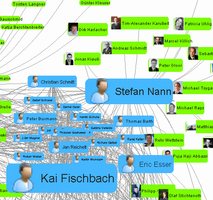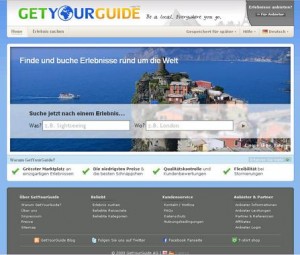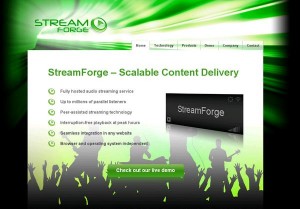The following are my chaotic notes from the Web Monday Zurich 2012 #3 at the SRF, the Swiss Radio and TV company. The topic was online media, how things are converging, and what to expect for the future. The presenters were SRF, Joiz, and Paper.li. The following notes are recountings from my head, not necessarily exactly what happened or what was said, it’s a bit Gonzo, and if that disturbs you then the Back Button is at your disposal. Continue reading Web Monday Zurich 2012 #3
Tag Archives: Web Monday
Web Monday Zurich 2012 #4
This Monday was Web Monday which means I had the chance to see the lounge of the Swisscom building for this 4th 2012 event of Zurich startups and ideas coming together. These are my notes from the event, taken largely in the Gonzo style and sent off to press with minimal editing. Inaccuracies, misspelled thoughts and rampant exaggerations are to be expected. Read at your own risk…
There were just two fantastic topics on hand at this fine Web Monday Zurich: the Blue Lion incubator and Online conversion / optimization for startups, our fantastic host was Swisscom, the main telecommunications company in Switzerland. Continue reading Web Monday Zurich 2012 #4
Web Mobile Monday #2 Zurich 2012
I headed to Web Monday Zurich 2012 #2, which also happened to be Mobile Monday, it was a shared event at the HP building in Dubendorf, and the topic was Native vs. Hybrid vs. Web apps. As I’m now involved with developing Lost In Reality, a mobile storytelling app, I’m very into this topic of choosing native vs. web/hybrid, so this gathering came at the perfect time for me. The following is a recap from my iPad notes, I’m intermixing what the speakers said with what I thought in my head, so hold on as this recollection could get hairy. There were three excellent speakers:
- Markus Leutwyler, HP: General overview on Web vs. Mobile vs. Native Apps
- Colin Frei, Liip: A case study on web / hybrid apps
- Vikram Kriplaney, local.ch: A case study on native apps
 Markus Leutwyler from HP (@twtomcat)
Markus Leutwyler from HP (@twtomcat)
History:
Now everyone is an expert and can make a web page, mobile started two three years ago, now the app is on the rise, we go to apps, not webpages. So now where are we today? Can everyone make a web app now? The web has a low entry barrier and it’s everywhere, browsers are everywhere, and now it is also an application platform. So what are native, hybrid, and web apps?
Native:
iOS, Android, Blackberry, Windows Mobile, you use a variety of languages based on the app market you want to target. Why native? Go native for performance, offline mode, find ability, device integration, monitization, user experience. You can make money with app stores. But what exactly is the native advantage? For example, now with WebGL we can do 3D in HTML.
Web App/Hybrid:
Html5, JavaScript, canvas, OpenGL, web sockets, css3, phone gap, ability to code one and export to different places (like with build.phonegap.com) Code reuse, common technologies, low entry barrier, cross-platform, familiar tools and techniques. While this doesn’t work for all applications just look at the trends, JavaScript performance is improving, hardware acceleration is coming, rapid browser evolution (short release cycles for Firefox), new tools frameworks coming out all the time.
Web vs Web Apps
Basically a web app is installed and able add to home screen. Then you have ChromOS, boot2gecko, where it simulates the native experience.
 Collin from Liip (@colinfrei)
Collin from Liip (@colinfrei)
Why do an app instead of a web page? To access device functionality, camera, etc. discover ability via app store, reach different audiences than via a Google search, selling your app, ability for in-app subscriptions, easy for people to tap and spend money. Barriers? NIWEA is an answer, wrap your content in an app container, hence you can use Cocoon, Phonegap, etc.
- Phonegap: it is a container, gives access to device functionality via API using JavaScript. What are the advantages?
- Knowledge: many web developers know JavaScript, lower barrier to entry, portability, can reuse the code for different devices.
- Portability: Means you can view the sites on your browser, if you write the code well you can port the stuff anywhere and reuse it. All these things affect costs, so hybrid allows you to use advantages of native.
Phonegap is good with APIs that are wide ranging, and then use plugins to offer specific functionality, but it isn’t universal. In the end you still have to write some unique code for different devices and their unique app needs. Concerning app performance, native is always better by definition, and it depends on your use case, like games that are device intensive for hardware optimization, but you can try game closure and cocoon.js, it all depends on what your goal is.
TV App for Tages-Anzeiger:
The purpose of the app is that they just show you the good TV shows, based on their recommendations. You can stream output to your tv and devices, it’s free to try and then is subscription based. It’s an iPad app, but lots of it was Html5 and JavaScript. Video is done via Html5, Phonegap was used to wrap it for the app store. In-app plugin purchases was used for monitization. Did not do much with portability to other devices because everyone is using the iPad anyways. Development done in the browser and tested, then ported to iPad. In total, everything was good with using phonegap.
The Future
Hybrid is expected to be the future. Using the same code base is such an advantage in development. The hybrid aspect becomes much smaller, browsers will be able to implement device features, like camera tag in html5, that is now possible. Check mozilla API , see what sensors you will be able to access.
 Vikram Kriplaney local.ch mobile architect
Vikram Kriplaney local.ch mobile architect
(@krips)
At local.ch they look at the breakdown of numbers for devices, iOS, android, etc. Why native? Well when they started developing for mobile it was 2008, they had expertise in iPhone, they had a mobile website, it was logical to first get a launcher from the phone and then just use the mobile optimized webpage.
In the end, user experience is biggest reason to go native. The user has expectations for that device, and they should respect that experience designed for that device. Performance is a big reason as well. Trust that the device maker has done all the optimization needed to give good UX via tight integration with hardware. Integration with other apps also good – more fine grain control. Now there are more frameworks than platforms for development, some are cross platform, some more on web side.
Leaky abstractions: any nontrivial abstraction will leak, you want to forget the details, but you end up for developing for each platform anyways. So why not go fully native from the start? Naturally for this you need a team with a wide range of competence, which local.ch has. The more audience they have on any platform, the more effort they put into developing for that platform as the platform evolves, launcher the web, hybrid, native. They do do hybrid, do it when it makes sense.
End Questions/Comments
- Is local storage a problem? In principle, offline functionality is not a problem.
- For testing, you can do automated builds and do UI testing with test flight.
- Backbone, spine as single page applications, for more responsive website.
- Yes mobile is going to take over.
Web Monday Zurich #11
 The days after a Web Monday Zurich (01.12.2009) is always hard on my head – still exploding from the tech-inspiration from the night before. On nights like this I need to find a dim place with mellow music and down a beer, sometimes with a chocolate brownie to calm my mind (this often happens at Alltag in Winterthur). The 11th Web Monday Zurich took place in the Zurich Google offices, that alone was enough of a reason to attend, the technology insight was just a bonus. There were three topics; Panoramio, UBS Web 2.0, and Mathias Vogel. Then I got a chance to tour through the Google offices.
The days after a Web Monday Zurich (01.12.2009) is always hard on my head – still exploding from the tech-inspiration from the night before. On nights like this I need to find a dim place with mellow music and down a beer, sometimes with a chocolate brownie to calm my mind (this often happens at Alltag in Winterthur). The 11th Web Monday Zurich took place in the Zurich Google offices, that alone was enough of a reason to attend, the technology insight was just a bonus. There were three topics; Panoramio, UBS Web 2.0, and Mathias Vogel. Then I got a chance to tour through the Google offices.
 The Panoramio presentation wasn’t so much about the software, but more of a how-I-woke-up-and-found-myself-successful talk by Joaquin Cuenca Abela. Joaquin sounds like the type of startup personality everyone imagines it should be like. A basic idea, applied to a certain technology, you keep pushing your ideas, and for some reason you get a call when you’re in the mountains to hear that your one server has crashed and your idea is becoming a success. Joaquin tried a few different ideas before thinking it would be a good idea to allow people to post pictures on Google Earth (the purpose of Panoramio). Basically they did that, eventually Google got interested in it and added it as an option on Google Earth. Then the server crashed and they knew they had arrived. It’s the feel-good type of story that makes a person want to quit their job and sit around an apartment drinking beer and programming. However, the real essence of the talk was that one should just keep trying with their ideas, many successful web startups are by people who are not necessarily super smart or unobtainably talented. Just do what feels right, respect you decisions and try different things to find out what works.
The Panoramio presentation wasn’t so much about the software, but more of a how-I-woke-up-and-found-myself-successful talk by Joaquin Cuenca Abela. Joaquin sounds like the type of startup personality everyone imagines it should be like. A basic idea, applied to a certain technology, you keep pushing your ideas, and for some reason you get a call when you’re in the mountains to hear that your one server has crashed and your idea is becoming a success. Joaquin tried a few different ideas before thinking it would be a good idea to allow people to post pictures on Google Earth (the purpose of Panoramio). Basically they did that, eventually Google got interested in it and added it as an option on Google Earth. Then the server crashed and they knew they had arrived. It’s the feel-good type of story that makes a person want to quit their job and sit around an apartment drinking beer and programming. However, the real essence of the talk was that one should just keep trying with their ideas, many successful web startups are by people who are not necessarily super smart or unobtainably talented. Just do what feels right, respect you decisions and try different things to find out what works.
 Next up Andreas Hoffmann gave a presentation on a challenge/contest from UBS. Basically, UBS wants to know how to use Web 2.0 in the banking business. All they want is 4-5 PowerPoint slides by Dec. 24th explaining your concept (details at the Web Monday Zurich project on Amzaee). The top three winners get 5000 CHF each. Sounds pretty sweet, pretty basic, straight-forward, everything you always expected in an idea contest. Since I’m an idea man I’m planning to brainstorm some ideas and send it in. After all, I’m a UBS banking customer, and if I can tell them how I want Web 2.0 in my banking life and they’re going to take me seriously, well, that’s worth a few nights at the coffee shop combined with some scribbles on a piece of paper on the way back from a night out in Zurich.
Next up Andreas Hoffmann gave a presentation on a challenge/contest from UBS. Basically, UBS wants to know how to use Web 2.0 in the banking business. All they want is 4-5 PowerPoint slides by Dec. 24th explaining your concept (details at the Web Monday Zurich project on Amzaee). The top three winners get 5000 CHF each. Sounds pretty sweet, pretty basic, straight-forward, everything you always expected in an idea contest. Since I’m an idea man I’m planning to brainstorm some ideas and send it in. After all, I’m a UBS banking customer, and if I can tell them how I want Web 2.0 in my banking life and they’re going to take me seriously, well, that’s worth a few nights at the coffee shop combined with some scribbles on a piece of paper on the way back from a night out in Zurich.
 Last up Mathias Vogel talked about the Fachhochschule Nordwestschweiz (FHNW). The FHNW school is interested in applied research, which means creating prototype technologies, serving industry partners, as opposed to basic science and writing publications (like at ETH Zurich). The program is currently after woman and industrial partners at the moment, with one goal being making computer science more attractive to women. I like this idea, and I can understand the motivations but generally dislike programs which separate one group of people from another at this level. I sort of felt excluded in many ways from the research communities in the United States because such a great push was made in universities and companies to recruit everyone who isn’t a white male (and that would be me). I decided to do research work at ETH Zurich largely because they seemed to be interested in results and ethics more than looks or gender. I think the best way to get more woman into the tech fields is to do more outreach at the lower levels and preschools and teach children at an early age not to exclude colleagues because of their gender or skin color. Pushing for women at the professional level, after they’ve already gone through a male-biased system and are already taking a research carrier direction (already succeeded despite the roadblocks) seems like a good start, but I think that giving support to tech-minded girls so they realize they could become startup-creating-women could have a greater influence (hmmm, sounds like a cool Amazee project idea). But now I’m interjecting random commentary where it might not belong (or does it?).
Last up Mathias Vogel talked about the Fachhochschule Nordwestschweiz (FHNW). The FHNW school is interested in applied research, which means creating prototype technologies, serving industry partners, as opposed to basic science and writing publications (like at ETH Zurich). The program is currently after woman and industrial partners at the moment, with one goal being making computer science more attractive to women. I like this idea, and I can understand the motivations but generally dislike programs which separate one group of people from another at this level. I sort of felt excluded in many ways from the research communities in the United States because such a great push was made in universities and companies to recruit everyone who isn’t a white male (and that would be me). I decided to do research work at ETH Zurich largely because they seemed to be interested in results and ethics more than looks or gender. I think the best way to get more woman into the tech fields is to do more outreach at the lower levels and preschools and teach children at an early age not to exclude colleagues because of their gender or skin color. Pushing for women at the professional level, after they’ve already gone through a male-biased system and are already taking a research carrier direction (already succeeded despite the roadblocks) seems like a good start, but I think that giving support to tech-minded girls so they realize they could become startup-creating-women could have a greater influence (hmmm, sounds like a cool Amazee project idea). But now I’m interjecting random commentary where it might not belong (or does it?).
 As part of the FHNW program two projects were also presented. Amazee is included in one of their partner projects, one goal being the creation of a sort of Karma Index into the Amazee system, which will include a recommendation engine so that new users are quickly connected with other users with similar interests when they join. I find this to be fantastic, because the first thing you wonder about when joining an online organization like Amazee (or Stylished, or Talenthouse, or Flickr) is how to find the people you want to work with. My mind had become a tad befuddled by this point from the free beer, but it was able to coherently listen to the presentation of the Galaxyadvisors.com website. It’s basically a connection engine, trolling through networks picking out connections between different people, creating connections between them, and then displaying this as a giant web. I’m more or less smart enough to appreciate the full value of it, as were most people in the room. I’m going to keep tabs on Galaxyadvisors, as many great things could come from it.
As part of the FHNW program two projects were also presented. Amazee is included in one of their partner projects, one goal being the creation of a sort of Karma Index into the Amazee system, which will include a recommendation engine so that new users are quickly connected with other users with similar interests when they join. I find this to be fantastic, because the first thing you wonder about when joining an online organization like Amazee (or Stylished, or Talenthouse, or Flickr) is how to find the people you want to work with. My mind had become a tad befuddled by this point from the free beer, but it was able to coherently listen to the presentation of the Galaxyadvisors.com website. It’s basically a connection engine, trolling through networks picking out connections between different people, creating connections between them, and then displaying this as a giant web. I’m more or less smart enough to appreciate the full value of it, as were most people in the room. I’m going to keep tabs on Galaxyadvisors, as many great things could come from it.
After the talks I walked around the room enjoying two quick glasses of wine talking with cool people, and then took a tour of the Google offices half buzzed on vino. The experience was…fantastic. You don’t need to be half buzzed to enjoy the Google offices, but it does enhance the experience. Just walking around you feel drunk, wondering if it’s possible, or if you’re simply hallucinating, can it be possible for offices be this “cool?” No, this is madness, surely I drank a bottle of bottle of Jack at my apartment and am simply losing all functions of my mind, and as a last gasp before dying my brain has created this fantasy land for me to enjoy before I cease to exist. But this actually happened, and I have pictures to prove it, as well as a video of my shoes sliding down a pole instead of taking the stairs.
Web Monday Zurich #10
 Web Monday Zurich is a meeting setup on Amazee.com to enable interaction between people in the web community around Zurich. Startups have a chance to present their ideas and get feedback, everyone has a chance to mingle and network, feed your brain and your innovation side in social atmosphere, how can you not go?
Web Monday Zurich is a meeting setup on Amazee.com to enable interaction between people in the web community around Zurich. Startups have a chance to present their ideas and get feedback, everyone has a chance to mingle and network, feed your brain and your innovation side in social atmosphere, how can you not go?
I wanted to attend my first Web Monday at the end of August, companies like MAGMAG Magazines were presenting, and being a photographer looking for new ways to present visual content, I was eager to see what was up. But that Monday I had just flown back from shooting a wedding in Rome, had picked up some sort of sickness, and took down the wrong address. So I ended up looking for Feldstrasse 113, a fictions address just different enough from Feldstrasse 133 to make me think I was going out of my mind.
Web Monday #10 was held in the Amazee office at the Technopark in Zurich (I was there before for a booster party), and my mind was sharp, so it was problem to find and attend. I could have stayed home and played with my new Octabox, but I was itching to infuse my mind with something new.
Two companies presented, GetYourGuide.com and StreamForge.
So, there’s like a thousand travel website on the net, you can book a flight, book a hotel, book a car, book a train…but what about booking “an experience?” GetYourGuide is a newly out of Beta website Startup which seeks to connect trip provides (suppliers) with people looking for travel experiences (customers). The idea is you head to the website and and quickly search through destinations or activities and quickly find a cool experience, like a city tour, bike tour, etc. I see a lot of potential for GetYourGuide, because I’ve been in a position to use it many times. During the Spring I was in San Diego and L.A. for a few weeks. In San Diego I was trying to book a kite boarding class, in L.A. I was searching for the best graffiti. I ended up buying some Bratz dolls and shooting them on the streets of the cities. So, in the end I didn’t learn to kite board, but did have a cool experience. However, I didn’t end up kite boarding because by the time I found a school, I had run out of time and had to fly back to Zurich. For a travel consumer such as myself, GetYourGuide can offer a lot of value, and I’ll use it to find a cool trip in the next city I visit.
For trip suppliers GetYourGuide is attractive, because it connects the local suppliers to the global customer directly. It includes a very nice back-end with analytics software to help suppliers see how people are visiting their trip listings. At the moment GetYourGuide is targeting popular destinations, and finding trip suppliers in those main cities. This is nice strategy, as they can bring in revenue quickly, and then expand to targeting trip suppliers in broader destinations. This is what interests me the most, because if you’re looking for a cattle driving experience in New Mexico and you live in Stuttgart, it’s not so easy to do. I also had problems in the past contacting mountain guides in Bolivia when I flew down there. I think if GetYourGuide expands into these areas and eventually targets specialty suppliers, they’ll set themselves apart from their competitors like Viator.com and have a web company offering a lot of value to their customers and suppliers. I’m looking forward to a travel experience-enhanced future.
So, when Barack Obama was giving his inauguration speech, so many people tuned in that the video feed was unavailable, the internet was broken – overloaded, users were blocked, their experience ruined. I didn’t watch the speech, but I do recall trying to watch the 2009 Leica webcast during the launch of their new cameras, the S2, X1, and M9. Their servers were overloaded and I had to read about it on a forum, how disappointed I was. How can we avoid this in the future? By using Peer-to-Peer strategies like those employed in LimeWire and previously in Napster (and now many others).
Instead of downloading the video or audio content directly from a website, parts are downloaded from other people who are downloading the same content. This removes the load from the main server, and enables people to maintain their enjoyment of the internet without overloading the system. This isn’t a new idea (in principle) it was tried (and failed) in the past. But StreamForge is using technology developed from the latest research at ETH Zurich, and like many technologies, the subsequent try is often far better than the first attempt.
Like (as far as I know) all Peer-to-Peer sharing platforms, StreamForge does require that their software be downloaded and installed by users, otherwise they wouldn’t be able to upload data and remove the load on the main server. But this presents a potential problem, because many consumers are wary of installing random programs which are connected to the internet, even though it may not be any different than using a webpage. Also, this is a technology which the main server companies need to adopt and trust in. If these two barriers can be overcome, then StreamForge has a bright future. There are other examples of companies with similar problems. Flash was introduced something like many, many years ago, but it’s really only in the last few years that it’s gained wide acceptance, and nearly every web browser has it installed.
Brass Tacs
Web Monday #10 rocked, I love seeing how different technologies develop and how new companies launch and present themselves. It’s very inspiring, and makes you think in new ways (at least, it works for me). I had an excellent time at Web Monday #10, I’m sad I missed #9, and am looking forward to #11, which will include presentations by Prof. Manfred Vogel from FHNW, Joaquin Cuenca Abela from Panoramio and Andreas Hoffmann from UBS (there’s a contest in the works).
The next Web Monday is coming up on Nov. 30th, location to be announced. Check out the Web Monday Zurich magazine on Amazee for further details. Also, STARTWERK.CH was a German write-up on Web Monday #10.

